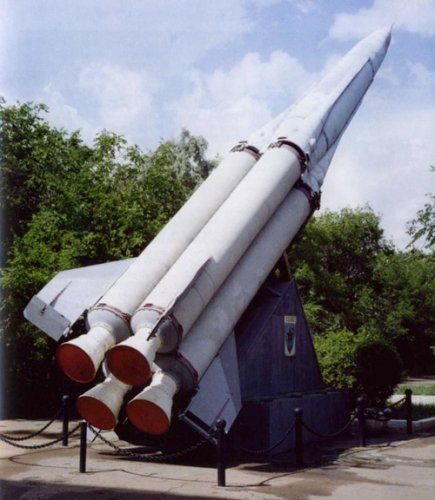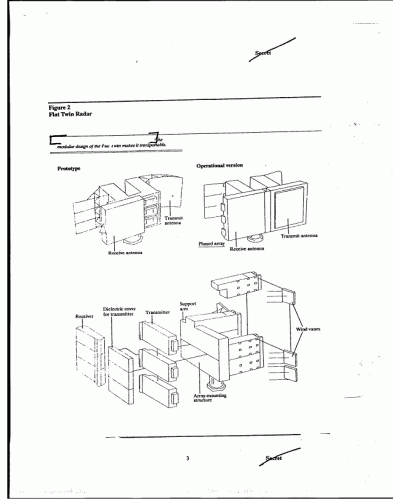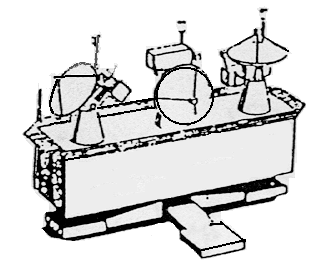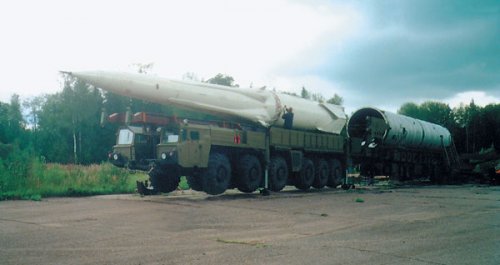ABM-1A/B
Soviet Designation: A-35/A-35M
Designer: G.B. Kisunko, SKB-30 Vympel
Operational: Entered service in 1972/1978, phased out in ?
Missile
Designation: A-350Zh, A-350R
Western Designation: Galosh Mod 0/Mod 1
Designer: P.D. Grushin, OKB-2 Fakel
Lenght: 19.8 m
Diameter: 2.57 m
Wingspan: 6.0 m
Launch Weight: 32,700 kg
Warhead: 1 MT nuclear
Propulsion: Solid-propellant rocket booster + RD-015T ramjet sustainer + solid-propellant/liquid-propellant rocket third stage
Guidance: Radio command/active radar homing
Max Range: 350 km
Ceiling: 120 m
Max Speed: Mach 4
Components:
11 x Dnestr/Dnepr/Daugava early warning radars (HEN HOUSE), range 3,500 km.
1 x Central command and 5E92B computer system.
1 x Dunai-3 target acquisition radar (DOG HOUSE), range 2,800 km.
1 x Dunai-3U target acquisition radar (CAT HOUSE), range 4,500 km.
4 x Launch sites with
1 x Command post.
1 x RKTs target tracking radar (TRY ADD).
2/1 x RKI ABM tracking and guidance radars (TRY ADD).
16 x Missile launch tubes with one A-350 missile.
Description
The development of an ABM system for the defense of Moscow was authorized on 8 April 1958. Further development of the A-35 system to defeat Minuteman-2 and Titan-2 ICBM warheads was ordered in 1960, and the first draft project was defended in the fall of 1962. It featured eight Buniy-3 early warning radars, 32 launchers, and a conventional fragmentation warhead for the missile. Construction of the ABM sites around Moscow started in 1962 using the infrastructure of the S-25 (SA-1) SAM system. At the same time, the Aldan experimental version was built to Sary Shagan, where tests began in 1967. Amongst other changes, the revised draft project presented in 1964 provided for a two-phase implementation of the system. In the first phase the missile was command guided to a point defined by ground-based computers. This version became operational in June 1972. The second phase system used active radar homing, and was first tested in 1974. During tests, the target missiles were R-12 (SS-4) and R-14 (SS-5) IRBMs. The final system update was made in 1977.
The A-350 was the first Soviet solid-propellant missile with gimballed nozzles. Tests of the A-350Zh missile were finished in 1973, and those of the radiation-hardened A-350R in 1974. The Aldan experimental launch complex consisted of a reduced scale command and control center, one Dunai-3UP radar (TOP ROOST), and three launchers. The main command and computing center was built 70 km west from Moscow adjacent to the Dunai-3 radar. The radar has a 65 degree field of view. Its construction began in 1962 near Kubinka, and it entered service in 1968. A fire on 8 May 1987 destroyed the radar's command center. The Dunai-3U radar at Chekhov facing China scans a sector of 51 degrees in azimuth and 48 degrees in elevation. It can track 30 ballistic targets simultaneously. The radar was modified in the 1980s to widen its scanning sector to include the southern parts of West Germany to detect Pershing-2 IRBM launches. The A-35 system was incapable of intercepting MIRV warheads. It was comparable to the US Nike-Zeus system. The A-35 was originally designated SH-01 and the A-35M SH-04 by the US DoD. Two launch sites were modernized to the A-35M configuration.













